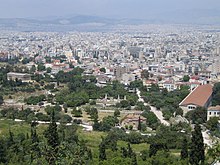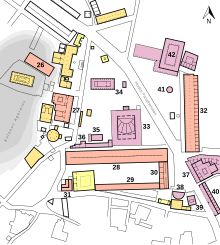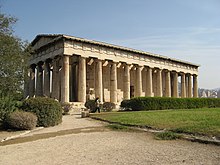
The Stoa of Attalos was a stoa in the Agora of Athens, Greece. It was built by and named after King Attalos II of Pergamon, who ruled between 159 BC and 138 BC. The building was reconstructed from 1952 to 1956 by the American School of Classical Studies at Athens and currently houses the Museum of the Ancient Agora.
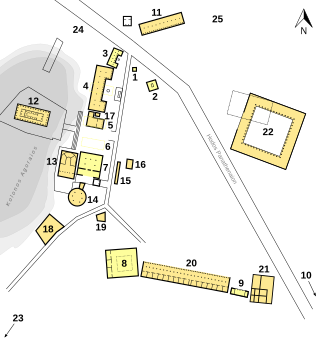
The Stoa Poikile or Painted Portico was a Doric stoa erected around 460 BC on the north side of the Ancient Agora of Athens. It was one of the most famous sites in ancient Athens, owing its fame to the paintings and war-booty displayed within it and to its association with ancient Greek philosophy, especially Stoicism.
Homer Armstrong Thompson was a Canadian classical archaeologist of the twentieth century, specializing in ancient Greece. As a fellow of the American School of Classical Studies at Athens, Thompson led the excavations of the Athenian Agora from May 25, 1931 until 1970. He was married to a fellow archaeologist, Dorothy Burr Thompson.
William Bell Dinsmoor Jr. was an American classical archaeologist and architectural historian.
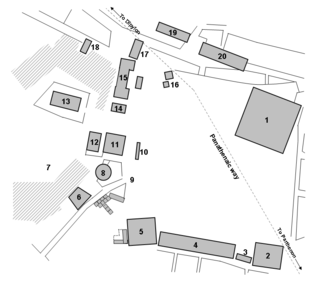
Stoa Basileios, meaning Royal Stoa, was a Doric stoa in the northwestern corner of the Athenian Agora, which was built in the 6th century BC, substantially altered in the 5th century BC, and then carefully preserved until the mid-second century AD. It is among the smallest known Greek stoas, but had great symbolic significance as the seat of the Athenian King Archon, repository of Athens' laws, and site of "the stone" on which incoming magistrates swore their oath of office.

The South Stoa I of Athens was a two-aisled stoa located on the south side of the Agora, in Athens, Greece, between the Aiakeion and the Southeast Fountain House. It probably served as the headquarters and dining rooms for various boards of Athenian officials. It was built at the end of the 5th century BC and remained in use until the mid-second century BC, when it was replaced by South Stoa II.

The Odeon of Agrippa was a large odeon located in the centre of the ancient Agora of Athens. It was built about 15 BC, occupying what had previously been open space in the centre of the Agora. It was a gift to the people of Athens by Marcus Vipsanius Agrippa, a Roman statesman and general.

The Temple of Ares was a Doric hexastyle peripteral temple dedicated to Ares, located in the northern part of the Ancient Agora of Athens. Fragments from the temple found throughout the Agora enable a full, if tentative, reconstruction of the temple's appearance and sculptural programme. The temple had a large altar to the east and was surrounded by statues. A terrace to the north looked down on the Panathenaic Way. The northwest corner of the temple overlays one of the best-preserved Mycenaean tombs in the Agora, which was in use from ca. 1450-1000 BC.

The Monument of the Eponymous Heroes, located in the Ancient Agora of Athens, Greece adjacent to the Metroon, was a marble podium that bore the bronze statues of the heroes representing the phylai (tribes) of Athens. The monument was surrounded by a wooden fence on stone posts. All that remains on the modern agora are pieces of a long statue base with the space for ten statues and two tripods at the ends with a partially restored fence. The large size and prominent position make the monument into a landmark for the Agora visitors.

The Sanctuary of Aphrodite Urania was located north-west of the Ancient Agora of Athens and dedicated to the goddess Aphrodite under her epithet Urania. It has been identified with a sanctuary found in this area in the 1980s. This sanctuary initially consisted of a marble altar that was built around 500 BC and was gradually buried as the ground level rose. Another structure, perhaps a fountainhouse, was built to the west ca. 100 BC. In the early 1st century AD, an Ionic tetrastyle prostyle temple closely modelled on the Erechtheion's north porch, that was built to the north of the altar.

The Temple of Apollo Patroos is a small ruined temple on the west side of the Ancient Agora of Athens. The original temple was an apsidal structure, built in the mid-sixth century BC and destroyed in 480/79 BC. The area probably remained sacred to Apollo. A new hexastyle ionic temple was built ca. 306-300 BC, which has an unusual L-shaped floor plan. Some fragments from the sculptural decoration of this structure survive. The colossal cult statue, by Euphranor, has also been recovered.

The Church of the Holy Apostles, also known as Holy Apostles of Solaki, is located in the Ancient Agora of Athens, Greece, next to the Stoa of Attalos, and can be dated to around the late 10th century.
Susan Irene Rotroff is an American classical archaeologist, classicist, and academic, specialising in the art, archaeology, and pottery of Ancient Greece. She was Jarvis Thurston and Mona Van Duyn Professor in the Humanities, at Washington University in St. Louis.

Mary Alison Frantz was an American archaeological photographer and a Byzantine scholar. She is best known for her work as the official photographer of the excavations of the Agora of Athens, and for her photographs of ancient Greek sculpture, including the Parthenon frieze and works from the Temple of Zeus at Olympia.
The New Bouleuterion is an ancient building in the city of Athens in Attica, Greece. It was located on the western side of the Ancient Athenian Agora. It is a theater with 12 rows of seats, with a seating capacity of greater than 500. A bouleuterion, sometimes translated as council house, assembly house, and senate house, was a building in ancient Greece which housed the council of citizens of a democratic city-state.

The Library of Pantainos was a building in ancient Athens. It was located at the southeast end of the Agora of Athens, south of the Stoa of Attalus, on the left side of Panathenaion Street. It was built by the Athenian philosopher Titus Flavius Pantainos between 98 and 102 AD, during the reign of the Roman emperor Trajan. The library building was dedicated to Athena Archegetis, with Trajan himself and the people of Athens, according to an inscription on the lintel of the main entrance, which is preserved embedded in the late Roman wall,.

The Southwest Temple is the modern name for a tetrastyle prostyle Doric temple located in the southwest part of the Ancient Agora of Athens. Fragments from the temple found throughout the Agora enable a full, if tentative, reconstruction of the temple's appearance. These fragments originally belonged to several Hellenistic structures and a fifth-century BC stoa at Thorikos in southeastern Attica, but they were spoliated to build the temple in the Agora in the age of Augustus. It is unknown which god or hero the temple was dedicated to. It was spoliated to build the post-Herulian fortification wall after the Herulian sack of Athens in 267 AD.

The Southeast Temple is the modern name for an Ionic octastyle prostyle temple located in the southeast corner of the Ancient Agora of Athens. Architectural fragments from the temple enable a full, if tentative, reconstruction of its appearance.These fragments originally belonged to the Temple of Athena at Sounion at the southern tip of Attica, but they were spoliated to build the temple in the Agora in the first half of the second century AD. It was thus the last of several "itinerant temples," relocated from the Attic countryside to the Athenian Agora in the Imperial period. It is unknown which god or hero it was dedicated to. It was heavily damaged during the Herulian Sack of Athens in 267 AD and then spoliated to build the post-Herulian fortification wall.

South Stoa II was a stoa on the south side of the Agora in ancient Athens. It formed the south side of an enclosed complex called the South Square, which was built in the mid-second century BC and may have been intended for use as lawcourts.

The East Building was a rectangular structure at the south end of the Agora in ancient Athens. It was built in the mid-second century BC as the east side and main entrance to an enclosed complex called the South Square, which may have served as a commercial area or as lawcourts. The structure was damaged in the Sullan Sack of 86 BC and used for industrial purposes until the early second century AD when it was rebuilt. It was demolished after the Herulian Sack of 267 AD and used as building material for the Post-Herulian Wall.
